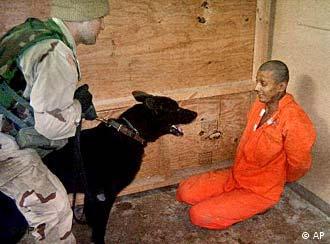Priests on trial for Arizona torture protest
Two California priests, Fransiscan Father Louis Vitale and Jesuit Father Steve Kelly, related to the Catholic Worker movement, were arrested in November 2006 for trespassing at Ft. Huachuca military base in Southern Arizona. They knelt in front of the entry gates to the base to pray, with 120 other protesters, and asked to deliver a letter to the former Chief of Military Intelligence in Iraq. Both have served time for Fort Benning "School of the Americas" protests. They were arraigned April 3 and are awaiting trial in June. From the group Pace e Bene and Redwood City Catholic Worker House respectively, the two are seasoned advocates of non-violence. According to the California Catholic Daily:
Vitale and Kelly were among 120 protesters at Ft. Huachuca. They claim U.S. military intelligence teaches torture interrogation techniques at Ft. Huachuca -- the same techniques used at Abu Ghraib and, allegedly, at Guantanamo.It is a small victory that the priests will remain free during the pre-trial period. Here is the text of the letter they attempted to deliver to Major General Barbara Fast:
It was at Ft. Huachuca that Vietnam-era manuals advocating torture techniques were translated into Spanish for use at the U.S. Army’s School of the Americas at Ft. Benning, Georgia -- a center that, critics have long said, has trained police and military officers who tortured and killed political enemies of repressive Latin American governments.
In November, Vitale and Kelly were arrested for kneeling to pray on the road leading to Ft. Huachuca’s gate. They face federal and state charges for refusing to follow police orders and for trespass. The priests attempted to speak to enlisted soldiers and to deliver a letter to Maj. Gen. Barbara Fast. “Nothing justifies the inhumane treatment of our fellow brothers and sisters,” said the priests’ letter. “Torture is a useless and unreliable tool that leads to an accepted practice of terrorization and the rationalization of wrongdoing.”
Fast had been chief of intelligence in Iraq, responsible for overseeing Abu Ghraib at the time of the tortures there. Exonerated of wrongdoing by military investigators, she was given command of the military intelligence center, located at Ft. Huachuca, in 2005.
Both Vitale and Kelly have been imprisoned before for anti-war and anti-torture civil disobedience. Vitale served time in 2002 and 2006 for protests at Ft. Benning and, in 2003, for obstructing traffic in San Francisco and blocking the entrance to the British Consulate there in protest of the Iraq War. Kelly has served time for attempting to disarm nuclear weapons delivery systems.
“I believe it is a way to raise consciousness,” Vitale told the San Francisco Faith in 2003. “I’m a strong a believer in something Martin Luther King called the ‘theology of stepping off the curb,’ as when he went to Selma and places like that. It’s putting your body there in a non-violent way.”
If convicted in June, Vitale and Kelly could be sentenced to up to ten months in prison.
To: Maj. Gen. Barbara Fast -
We are here today as concerned U.S. people, veterans and clergy, to speak with enlisted personnel about the illegality and immorality of torture according to international humanitarian law, including the Geneva Conventions.
We condemn torture as a dehumanization of both prisoners and interrogators, resulting in humiliation, disability and even death. In addition to the hundreds of detainees who have died, we are also concerned about U.S. military personnel. Alyssa Peterson committed suicide after participating in the torture of Iraqi prisoners. Lynndie England and others have been imprisoned for their illegal activities.
We are here today at Ft. Huachuca in solidarity with tens of thousands of people at the Western Hemisphere Institute for Security Cooperation at Ft. Benning, Georgia (formerly known as the School of the Americas) to say that the training of torturers must immediately stop. Nothing justifies the inhumane treatment of our fellow brothers and sisters. Torture by U.S. military personnel has reached alarming proportions and has horrified people around the world.
We are convinced that the Military Commissions Act of 2006 is unconstitutional. We totally reject its conclusions. Torture is a useless and unreliable tool that leads to an accepted practice of terrorization and the rationalization of wrongdoing.
We are here today to repent and clearly state that because of our sense of moral and human decency we condemn torture. NOT IN OUR NAME.
Signed this 19th day of November, 2006 -
Louis Vitale,OFM
Steve Kelly, SJ

Biographical data on Vitale and Kelly:
Fr. Louie Vitale is a member of Pace e Bene, whose mission is "to develop the spirituality and practice of active nonviolence as a way of living and being and as a process for cultural transformation." Fr. Vitale is also a co-founder of the Nevada Desert Experience, a faith-based organization that has opposed nuclear weapons testing for a quarter of a century. Fr. Vitale recently served six months in jail following his arrest at the Ft. Benning vigil in November, 2005, and was ejected from congressional hearings in September after speaking out against the Military Commissions Act.
Fr. Steve Kelly is a member of the Redwood City Catholic Worker community and has served time in federal prison for the nonviolent direct disarmament of nuclear weapon delivery systems. In December, 2005, Kelly served as chaplain for Witness to Torture, a delegation of over two dozen U.S. anti-torture activists who defied the U.S. embargo of Cuba with a peaceful march through that nation to the gates of the Guantanamo Bay navel base and prison camp.
Labels: abu ghraib, abuse, afghanistan, iraq, torture, whistleblower






























